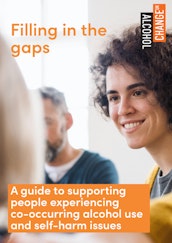Both drinking and self-harming are often coping mechanisms for mental distress, and both are often linked to trauma.
Alcohol problems are rarely simple. They may arise from past trauma or current adversity. They may be linked to other physical and mental health issues, and/or to social and relationship difficulties. They may cause, co-occur with, or result from any of these issues. This complexity cannot always be untangled and parcelled out for a range of specialist services to address – alcohol issues over here, mental health over there, and so on. To be effective, services need to see and support the whole person.[i] The relationship between alcohol use and self-harm is one very clear example of this, and research commissioned by Alcohol Change UK has shown:
- A clear but complex link between alcohol use and self-harm in some people’s lives
- A degree of separation between support services for self-harm (and mental health more generally) and alcohol treatment services, leaving gaps in provision through which some very vulnerable people may fall
- A pattern of unmet complex needs, and of people concealing the complexity of their needs (by not revealing either their self-harm or their alcohol use) in order to access services.[ii]
In addition, our conversations with practitioners in the fields of self-harm and alcohol use indicate that both sets of services are seeing people whose thoughts, feelings and behaviours are remarkably similar, in that both behaviours – drinking and self-harming – are often coping mechanisms for similar forms of mental distress. In short, the two issues are not as different as we at first supposed, and both are often linked to trauma and adversity.
In this guide, we have sought to examine and understand the experiences of people who are (or have been) both using alcohol and self-harming, and to offer some suggestions for ways for services to better support them. We expect the main audience for this guide to be substance use (drug and alcohol) treatment services and services specialising in self-harm support. However, it will be of use to a wide the range of services likely to encounter people facing these two challenges in life: social services, the emergency services, education providers, healthcare providers, and community and voluntary organisations supporting vulnerable people.
This is not a definitive treatment manual. Each practitioner must use their own professional judgement to tailor the support that they provide. What it does provide is some insights into what people with experience of alcohol use and self-harm say they need from services, and what practitioners have found useful in seeking to work with people in that situation.
Our hope is that this guide will enable workers in both self-harm and alcohol treatment services, and others, to increase their confidence and skills in working holistically with this group, and so improve outcomes and quality of life. We also hope that it will lead to more and better joint working and understanding between services: to the realisation of a “no wrong door” approach, whereby “every door in the…system should provide access to the services needed”.[iii] Given that both self-harm and harmful alcohol use appear to have increased amongst some of the most vulnerable sections of the population in recent years, this seems more important than ever.[iv][v][vi]
This is the first edition of this guide. We very much hope that it will not be the last, and that there will be future iterations as we learn more and improve our practice. We have made the guide available to download from our website, free of charge, in English and Welsh. If you have any comments or questions about the guide, or if you think there is anything we need to add, remove, or amend, please do get in touch with your views and ideas. We welcome feedback in both English and Welsh.
To arrange training from us on how to improve your organisation’s approach to co-occurring alcohol use and self-harm, contact [email protected].

